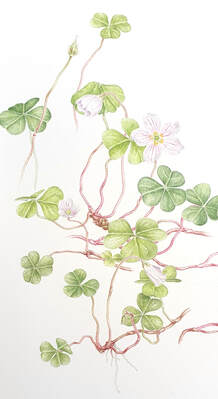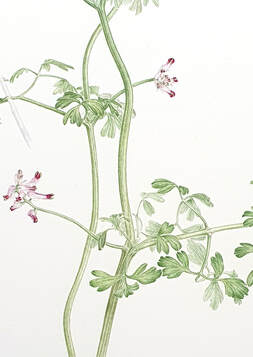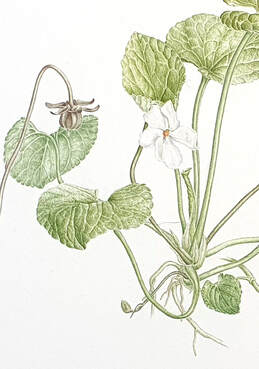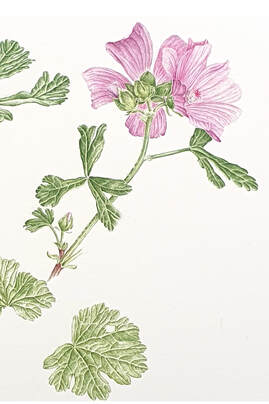Herbs of the River Usk Valley
The River Usk flows through the Brecon Beacons from its source on the Black Mountain, Mynydd Du, to Abergavenny and then down to Newport and the Severn Estuary. Much of its course is quite wild or has been farmed in a low impact way for many years leading to habitats rich in flora and fauna. At the small village of Talybont walking the wooded slopes of the valley feels like it could be much the same as when the poet and country doctor, Henry Vaughan , live in nearby Newton Farm in the seventeenth century. As as he walked the local paths, gaining inspiration for his poetry, he may well have been noting the local wild plants, many of which provided the basis of the medical treatments of the day. This collection of paintings was inspired by his life here and represents only a small fraction of the plants found in the woods and on the hills today.
|
SpeedwellsV. officinalis (illustrated, left) has long been recognised for its medicinal properties. It is said that "among the Welsh peasantry" great virtues are attributed to it and was still used in the 1930 and beyond. Speedwells grow plentifully and in a variety of habitats including in my garden, in the meadows and in the woods. Germander speedwell (V. chamaedrys, illustrated, right) was also used medicinally, but less is known about any medicinal virtues of the other four or so species of speedwell that grow abundantly locally.
|
|
|
Musk mallow (Malva moschata)Many species of mallow are said to have medicinal uses and most have also been used as foods - for instance a dish of marsh mallows was considered a delicacy for the Romans. The species illustrated here just popped up in my garden and later I noticed it growing on the roadsides and out of a few garden walls in Brecon. It is native to England and Wales and introduced in Scotland and Ireland. The root of this species has the same virtues as the marsh mallow, but is not quite as strong. Of marsh mallows, Pechy reckons it softens, discusses, eases pain and brings tumours to suppuration. He would use all the parts of the plant.
An Anglo Saxon text (from the Old English Herbarium and Medicina de Quadripedibus from manuscripts around the tenth century) says of mallow - Theos wyrt the man malue erratice oc othrum naman hocleaf nemneth byth cenned aeghwaer on beganum stowum. (whatever that means). Mallows were also used extensively by the Physicians of Myddfai (as documented around the fourteenth century, in the Red book of Hergest) who were located further west along the Usk. |
Wood Anemone (Anemone nemorosa)Wood anemones follow the lesser celandine in the woods around me changing the woodland floor from the bright yellow of the celandine to stars of white. In the wet they droop their heads down but on a warm sunny day they will raise them to the skies. A common name for it is wind flower. At the time of Henry Vaughan in the seventeenth century the wood anemone was on its way out as a medicine, for Parkinson it was almost out of favour, although it was referred to by Culpeper. .
|






